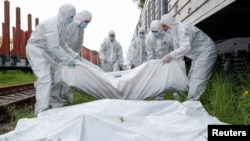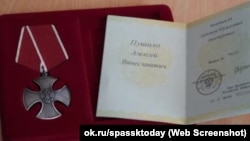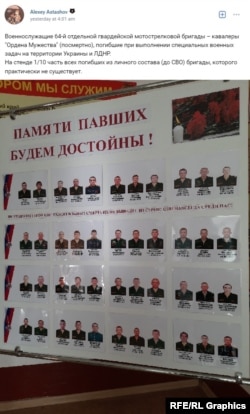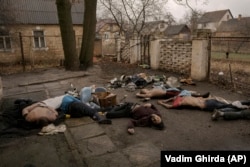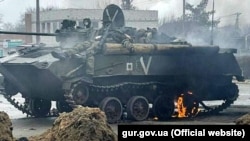At the headquarters of Russian military unit 51460 in the Far Eastern region of Khabarovsk, a memorial wall dedicated to the fallen soldiers of the unit, known more widely as the 64th Separate Guards Motor Rifle Brigade, was erected not long ago.
In all, 44 soldiers and officers are shown on the wall, according to a photograph that was initially posted to the Russian social media site VK and confirmed by RFE/RL.
The wall does not say where they were killed, only that they were all awarded the prestigious Order of Courage. Aleksei Astashov, the man who posted the photograph, told RFE/RL where: Kyiv, Izyum, and Slovyansk in Ukraine, where Russia's invasion is in its sixth month and where Western intelligence says Russia has suffered more deaths than it did in the entire decade of the Soviet war in Afghanistan in the 1980s.
"Everyone went to the SVO," Astashov told RFE/RL, using the acronym for "special military operation," the euphemism the Kremlin has insisted on using when discussing the war in Ukraine.
Everyone, he said in a chat conversation via VK, "except for girls, staff mice, and new recruits." Staff mice is a colloquial term for administrative and clerical staff.
That's 95 percent of the unit's officers and contract soldiers, including "semi-conscripts" who signed the contracts under duress, he said.
"Many were transferred to Ukraine directly from exercises in neighboring Belarus," he said.
According to Astashov, the size of the brigade when it deployed was about 1,500 troops. The total number of dead, by Astashov's estimate: "At least several hundred."
Russia's war on Ukraine has rewritten the security order of Europe, transforming alliances, prompting major redeployments of Western military units, scrambling the global economy, and hastening Russia's descent into authoritarianism.
It has also exposed glaring weaknesses in Russia's armed forces, with Russian units suffering extraordinarily high attrition rates.
Officially, Russia's Defense Ministry has released only partial tallies of war losses, the last on March 25, when it announced 1,351 dead and 3,825 wounded.
Last month, however, CIA Director William Burns estimated Russian losses were at least 15,000 killed and about 45,000 wounded, a figure echoed on August 8 by Colin Kahl, U.S. undersecretary of defense for policy.
"I think it's safe to suggest that the Russians have probably taken 70,000 to 80,000 casualties in less than six months," Kahl told reporters. "Now, that is a combination of killed in action and wounded in action, and that number might be a little lower, a little higher. But I think that's kind of in the ballpark, which is pretty remarkable considering that the Russians have achieved none of [Russian President] Vladimir Putin's objectives at the beginning of the war."
The 64th Separate Guards Motor Rifle Brigade may be the clearest example of this.
'The Motherland And The Interests Of The State'
Based in the Khabarovsk region, approximately 9,000 kilometers to the east of Ukraine, the rifle brigade was reorganized as a regiment in the 1990s, and parts of it were deployed to fight in Chechnya during the first war there in the 1990s. It was upgraded to a brigade-level unit in the late 2000s.
The unit gained global notoriety after Russian units withdrew from districts north of Kyiv in late March, repelled in their offensive toward the Ukrainian capital.
Several districts, including the town of Bucha, were the sites of mass killings of civilians and other alleged war crimes, according to Ukrainian investigators, rights groups, journalists, and open-source researchers. Ukraine's Defense Ministry accused the brigade, which was deployed to Bucha and nearby locations, of atrocities.
On August 8, Bucha authorities said they had tallied 458 bodies recovered in the town, of which 419 appeared to have been shot, tortured, or suffered blunt-force injuries.
Weeks after reports of the massacres first appeared, on April 18, Putin honored the 64th for defending the "motherland and the interests of the state." He praised it for "mass heroism and valor, tenacity, and courage."
According to the dates listed on the memorial wall at the 64th Brigade camp, about 20 minutes outside of Khabarovsk, at least 44 soldiers from the unit died in late February and March -- a period coinciding with the first phase of the Russian invasion, when Russian forces sought to seize Kyiv.
Other dates match up with a later offensive, after Russian commanders withdrew the 64th Brigade and other units from north of Kyiv and redeployed forces to the eastern Donbas region, including near Kharkiv.
According to the dates on the memorial wall, seven soldiers from the 64th Brigade were killed on April 25. That date coincides with a report by Ukraine's General Staff on the same day saying that Russian troops "tried to carry out assault actions" in the directions "Izyum-Barvinkove" and "Izyum-Slovyansk."
A week prior to that attack, a contract soldier from the 64th Brigade named Aleksandr Rostovsky also died. Online memorial announcements honoring him said he died on April 18 near Izyum.
'Don't Worry. I Love You. I Kiss You.'
In all, RFE/RL was able to corroborate the deaths of 30 out of the 44 soldiers featured on the memorial wall using publicly available information from official publications, social media, and media reports.
One such online announcement, published on VK, is called "Memorial to the Dead Transbaikalians" -- a reference to the southern Siberian region bordered on the west by Lake Baikal, on the south by the Mongolian border, and to the east by the Amur region.
A post dated May 14, written in honor of 20-year-old Corporal Vladislav Vedernikov, included a text message from his mother:
"He studied in Khabarovsk. He had already finished grade 11, and he was taking exams. But then they announced they would go to Belarus. There they dug trenches, and the last time he called was from Chernobyl," her post said.
On February 23, she wrote, her son sent a text message saying his unit was being transferred, that all phones were being taken away, and that there would be no more communication. "‘Don't worry. I love you. I kiss you,'" she quoted him as saying.
"On March 3, their column came under fire from two sides. The battle went on for two days. A fragment hit him in the leg. They brought some whole [bodies]; others were collected only in parts. He died in the Kyiv region, in Borodyanka," the post said.
KIA, MIA, POW
Russia's high rate of dead and wounded has been attributed to several factors, according to military experts.
Ukrainian forces have waged pitched battles defending not only the regions north of Kyiv, but other locations, including in the Donbas and the Azov Sea port of Mariupol, which Ukraine ultimately was forced to cede after a months-long siege.
Ukraine's defense has been substantially bolstered by the influx of sophisticated Western weaponry that has replaced dwindling Soviet-era stocks and has changed the capabilities of its armed forces.
North of Kyiv, in the early days of the war, Ukrainian troops made effective use of anti-tank missiles, such as the U.S.-built Javelin and the British NLAW, to pummel Russian tanks and other armored vehicles.
Other Russian weaknesses include a lack of proper medical equipment and modern techniques and procedures for quickly treating and evacuating battlefield injuries.
After Russia's retreat from the Kyiv region, many units had been decimated, according to U.S. military officials and outside experts. According to some estimates, some Russian units lost up to one-third of their personnel.
Michael Kofman, a longtime expert on the Russian military at the U.S.-based Center for Naval Analysis, has roughly estimated that for every Russian soldier killed, there were likely about 3.5 wounded.
Yury Fedorov, a Russian military expert, estimated the total personnel of the 64th Brigade, which includes two motorized rifle battalions and one tank battalion, was about 2,500 before the war.
"The 64th Separate Motorized Rifle Brigade is from the Far Eastern Military District, and there many units were severely weakened and poorly equipped," he told RFE/RL. "Often they were simply cut in half. For example, there are two more or less fully manned battalions and the rest are just a few officers and ensigns.
"If they receive additional personnel, then they must accept them, train them, lead them, and go into battle with them," he said.
"This is a common practice: If troops are badly battered, then some new consolidated brigades are made from the remaining pieces of one or another unit," Fedorov said. "In order to be combat-ready, such brigades need to go through the process of combat coordination. Platoon and company commanders must get to know each other, debug communication channels. This takes at least several months."
The 64th Brigade, however, cannot be disbanded, he argued, because doing so would undermine the honor bestowed upon it by Putin.
"To disband it means to recognize the responsibility of this brigade for the crimes in Bucha," Fedorov said. "Therefore, most likely, new contract soldiers and conscripts will be sent to the remaining officers."
Other analysts at the Conflict Intelligence Team investigative group say the casualty estimate offered by Astashov was plausible, but only if the figure was limited to contract soldiers.
Other factors that experts have blamed for Russia's high casualty rate include poor morale and poor discipline, particularly among the lower ranks and noncommissioned officers.
Astashov, who works in a medical unit with the 64th Brigade, told RFE/RL that at least 100 soldiers -- so-called "refuseniks" -- may have refused to fight in Ukraine, particularly after the initial battlefield defeats suffered by Russian forces.
"As in January, they were sent to Belarus for exercises and then back to Ukraine, but no one let them out" to go home or go on leave, he wrote in a lengthy VK conversation before he blocked an RFE/RL reporter from communicating further and switched his VK page to the "friends-only" setting.
"In fact, there was no rotation at all," he said. "There were at least 100 ‘refuseniks,' not after the first defeats, but after many [lies] on the part of commanders. The boys are tired of the intensity of fighting and movement, of the duration of the deployment, and the backdrop of uncertainty."




